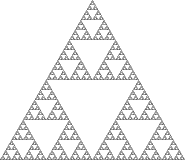Fractalfoundation.org
A fractal is a never-ending pattern. Fractals are infinitely complex patterns that are self-similar across different scales. They are created by repeating a simple process over and over in an ongoing feedback loop. Driven by recursion, fractals are images of dynamic systems – the pictures of Chaos. Geometrically, they exist in between our familiar dimensions. Fractal patterns are extremely familiar, since nature is full of fractals. For instance: trees, rivers, coastlines, mountains, clouds, seashells, hurricanes, etc. Abstract fractals – such as the Mandelbrot Set – can be generated by a computer calculating a simple equation over and over.
A fractal is a never-ending pattern. Fractals are infinitely complex patterns that are self-similar across different scales. They are created by repeating a simple process over and over in an ongoing feedback loop. Driven by recursion, fractals are images of dynamic systems – the pictures of Chaos. Geometrically, they exist in between our familiar dimensions. Fractal patterns are extremely familiar, since nature is full of fractals. For instance: trees, rivers, coastlines, mountains, clouds, seashells, hurricanes, etc. Abstract fractals – such as the Mandelbrot Set – can be generated by a computer calculating a simple equation over and over.
Mathematical fractals are generated by applying a feedback loop to a system.
Z = Z2 + C
Tathagat Varma.
- Mathematical fractals unlike natural fractals can keep self repeating indefinitely.
- They are the best examples of - Simplicity leads to complexity.
- They appear complex, but are essentially repeating a basic shape repeatedly, infinitely.
- Fractals are nature's mechanism to replicate organization without exhibiting a central control.
- Agility could be modeled as a fractal behaviour of software teams to ensure the core focus on agility loop is always retained, despite scale.
- In practice, the notion of agility at each level would undergo changes but the core behavior of agility loop gets preserved, and allows agility to grow scale free!






No comments:
Post a Comment